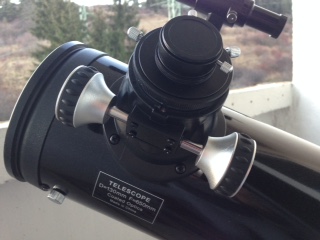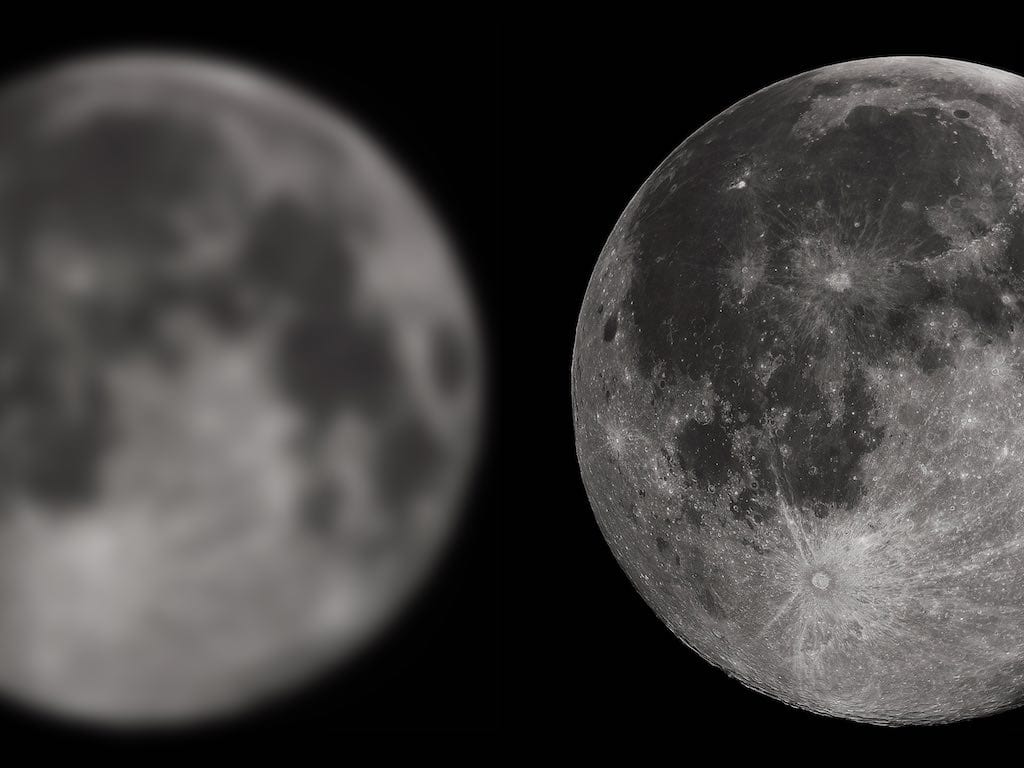This site contains affiliate links to products. I may receive a commission for purchases made through these links.
Achieving a crystal-clear image through your telescope’s eyepiece is crucial for a successful stargazing experience. However, perfecting the focus can often prove challenging.
Telescopes come equipped with various types of focusers, and the focusing technique can vary significantly between different models.
In this guide, I’ll walk you through the nuances of focusing a telescope, introduce you to the different types of focusers you might encounter, and share some useful tools and tips to help you achieve the sharpest focus possible.
Basic focuser
All basic focusers look the same. They have two wheels on each side. These wheels are used to move the focuser tube in and out of the telescope. When you put the eyepiece into the focuser, there is one point in the path where the light comes into focus – the focal point.
The purpose of the focuser is to get the eyepiece to that point so that you can see the clear image. Seems easy, but the focal point is a very small area.

There are a few factors that determine how hard it will be for you to focus on the image. The most significant factor is your telescope mount. You will notice while looking through the eyepiece that even if you touch the focuser wheel very gently, the image starts to shake.
You know it will be a struggle to focus it because you have to wait after every adjustment for the image to be still again.
Now, these shakes vary between the telescopes. If you want minimum shakes, you must have your telescope mounted on a very sturdy and professional mount. It will reduce the vibrations when touching the focuser. But there are tricks to improve the stability of the cheaper mounts too.
For example, you can hang something heavy on the mount base between the legs- some load you choose. This will move the center of gravity lower, your telescope will be more stable, and you will get fewer vibrations when touching it.
Dual Speed Focuser (DS)
You may also notice a problem in reaching the right spot to focus the image while adjusting the focuser with the wheels. You have to make very slight moves to get the best focus. However, you can overcome this with a dual-speed focuser.
Some telescopes already come with these focusers. They are usually in the higher price range, and you can find “DS” in the name of the telescope. The “DS” means that the telescope will come with a dual focuser.
If you already have a telescope at your home and it doesn’t have the dual-speed one, you can easily buy and upgrade it with the dual-speed focuser.
So what is the dual focuser? It looks like a regular focuser but with one small additional wheel on one side. This small wheel is for very slight adjustments while focusing.
First, you find the rough point where your image is focused, and then you can use the small adjustment wheel to reach the perfect focus.
These small wheels are usually 1/10th of the move compared to the bigger wheel on your focuser. Clearly, it’s very precise. Dual focusers are also used in astrophotography because the perfect focus is essential for a good image.
Electronic Focuser
This is more like an upgrade to your existing focuser.
It features a small device that is mounted on the focuser, or you need to replace one adjustment wheel with it. It is even better than the dual-speed focuser because you will get the very slight adjustment done by the electric motor, and also, you don’t have to touch your telescope.
All is done with the remote controller, so there are no image vibrations while focusing. You can even control the device with the software on your computer, which is very helpful for astrophotography or video astronomy. But not all focusers are suited for the electronic upgrade.
You need to do a little bit of research before buying one. You may find that you will need to replace the focuser as well. But if it is an important factor for you and you are doing astrophotography, it is worth doing.
All the big telescope manufacturers are making them.
The best practice is to look for the same brand of electronic focuser as your telescope. Some folks are able to build one themselves because it is not a complicated device. There are many tutorials on how to build one, and you can save some money and have some fun making it if you are an electrician or handyman.
Bahtinov Mask

I have talked about how you can help yourself with focusing, but how do you know that the image is in focus? I know, you can say you see it, and it is completely enough, but in astrophotography, we can’t trust our eyes.
Imagine a few hours of imaging session only to find out, while doing the image processing, that the images are not in the perfect focus, ouch. But don’t worry.
There are also a few tools that will help you with that. The first and most used one is called a Bahtinov mask.
This focusing aid is a cap you put on the front of the telescope. It has a special pattern invented by Russian amateur astronomer Pavel Bahtinov. When you put the Bahtinov mask on, it is important to point the telescope at some bright star. The pattern on the mask will create three diffraction spikes on the star.
Two are fixed and create the X sign. One spike is in the middle, and it moves when you are focusing on the telescope. Then you need to work with your focuser to get all three spikes crossing precisely in the middle of the star. This is the position where the optimal focus is achieved.

You may need to take a long exposure image to get the spikes in astrophotography. It depends on the brightness of the star you are using. While there is no problem with doing it with a camera, there is a problem when you want to use the mask to focus a telescope for visual observation.
Our eyes are not able to do long exposures. So when you want to do that only with the eyepiece and your eye, you need to use a very bright star-like Vega or Sirius to see the diffraction spikes created by the Bahtinov mask. It will be impossible with a dim star.
Also, remember that this focusing aid mask works only with stars. Maybe on some planets as well, but it is impossible to use it on the moon, even if it is very bright. The moon is too big for the mask to create the spikes, so remember, you always have to point the telescope at the star.
The Bahtinov mask is not a big investment, make sure to order the right size for your telescope, and it is also possible to create your own at home. I have also created one for myself, and it is working perfectly.
The only thing you need is to download a template, print it, and cut the pattern into cardboard or stiff paper. In my case, I created the pattern myself because there are no rules like the angle or width of the holes, and it was faster.
Hartmann Mask
If you want to focus big planet like Jupiter or the Moon, you can focus the telescope on the star first and then point it to the celestial body.
The focus should be optimal. But we also have focusing aid for these types of situations, for planets and the Moon. It is called a Hartmann mask, and it is a very simple tool. It is named after the German astronomer Johannes Franz Hartmann.
The Hartmann mask has three or more holes in it. There are versions with only two holes, but this type of mask is called a Scheiner disk. Many telescopes come with Scheiner disk because the telescope cap sometimes has two holes you can uncover and use for focusing.
But the Hartmann mask is more precise because of more holes. When you cover the telescope tube with it, it will create a few same images of the object your telescope is pointing at. How many depends on the number of holes in the mask.
The point is to join all the images into one by moving the focuser in and out. When all images join together and create only one image, the telescope is in optimal focus. It is very helpful to use with planets or the Moon.
In my opinion, buying the Hartmann mask is a stupid idea because it is so easy to make. The only thing you have to do is to cut a circle from the cardboard big enough to cover the front of the telescope and then make 3 holes in it. The holes must be symmetrical in the right positions, but it is easy to find them on the internet.
You may also like: How to Use a Telescope (Explained for Beginners)
Final advice
Reaching focus with the telescope also depends on many outside factors like current seeing conditions or the type of the telescope.
When the conditions are poor, the object can wiggle and wobble. It is caused by the atmosphere, and in this case, it is hard to focus, so focusing aid will help you with that.
Another problem can be with reflecting telescopes, also called Newtonians. These telescopes have an open tube, and they need some time to correct the temperature of the tube and the mirror before every use. When they are not cooled down enough before the session, it may cause problems in focusing on any object. This is not an issue with refracting telescopes using lenses.
The last thing to remember is that you always have to refocus the telescope after the change of the eyepiece. Every eyepiece will have a different focuser position, so don’t freak out when you change the eyepiece and you see nothing or the image is blurred. Just focus on the object again.
You may also enjoy:

